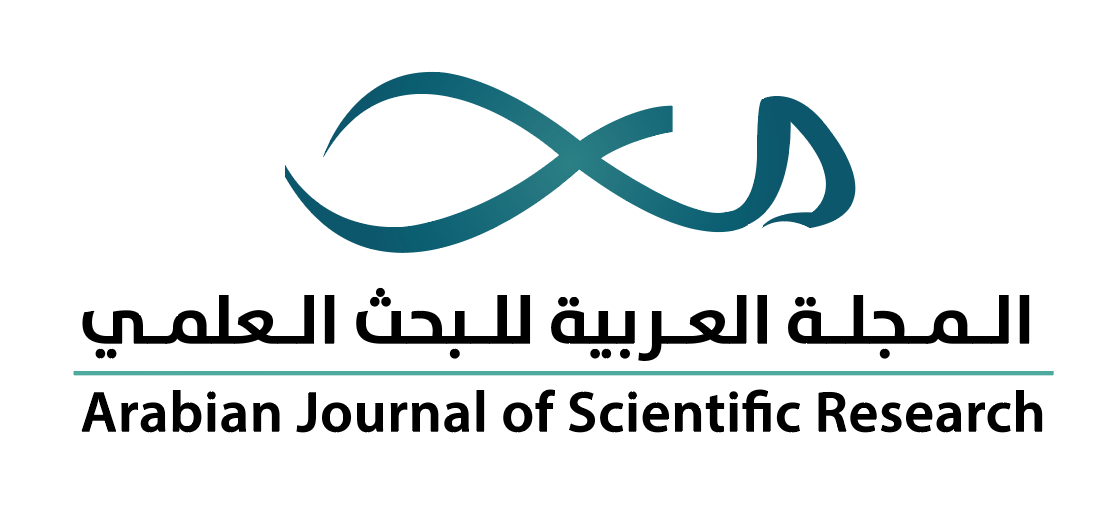- الرئيسية
- A-Z Publications
- Arabian Journal of Scientific Research-المجلة العربية للبحث العلمي
- الأعداد السابقة
- الأعداد السابقة
Arabian Journal of Scientific Research-المجلة العربية للبحث العلمي - الأعداد السابقة
المجلد 2 (2021), العدد 1
-
oa صبغة الأنثوسيانين الطبيعية تضاهي الصبغات الكيميائية
مزيد أقلالمؤلفون: السيد طاهر السيد حسن عقيل and نجوى إبراهيم البرهاويالملخص تستخدم هذه الدراسة الماء المقطر لاستخلاص صبغة الأنثوسيانين من بذور الرمان وأوراق اللهانة البنفسجية، وذلك أن الماء ليس له أي تأثير سُمّي، ويتبخر عند درجات الحرارة المنخفضة من دون التأثير في التركيب الكيمياوي للصبغة المستخلصة. وتبين الدراسة أن الصبغة الحمراء المستخلصة من الرمان كانت ذات وسط حامضي (pH= 3.0)، بينما كانت الصبغة البنفسجية المستخلصة من اللهانة ذات وسط حامضي خفيف (pH=6.0)، وبلغت تراكيز الصبغة في عصير كلا النباتين بعد إسقاط القيمة الامتصاصية لكل منها على منحنى المحا Read More
-
oa تقدير فعالية إنزيم (nitrate reductase) باستخدام دقائق الفضة النانوية المخلقة حيويًا من الفطرين (Pleurotus pulmonarius) و(Pleurotus ostreatus var ostreatus) وتأثيرها على الفطر (Pythium aphanidermatum)
مزيد أقلالمؤلفون: سيف سعدالله حسن and عبد الله عبد الكريم حسنالملخص أجريت هذه الدراسة في مختبرات قسم وقاية النبات بكلية الزراعة في جامعة تكريت خلال الموسم 2019/2018، بهدف دراسة فعالية إنزيم "اختزال النترات" (Nitrate reductase) باستخدام أربعة تراكيز (0.5 و1 و1.5 و2 ملي مول) من دقائق الفضة النانوية المخلقة حيويًا من الفطرين الغذائيين (Pleurotus Pulmonarius) و(Pleurotus ostreatus var ostreatus). لكل فطر أربعة أجزاء، هي راشح الفطر، والكتلة الحيوية، والمستخلص المائي الحار والبارد للكتلة الحيوية للفطر، ودراسة تأثير جسيمات الفضة النانوية على ا Read More
-
oa فعالية الزيوت الطيارة لقشور نوعين من فواكه الحمضيات على حلم العنكبوت (Tetranychus urticae Koch) (Acari: Tetraychnidae) والحلم المفترس (Phytoseiulus persimilis Athias-Henroit) (Acari: Phytoseiidae)
مزيد أقلالمؤلفون: أسماء البقالي العيساوي and أمال العمرانيالملخص تم استخلاص الزيوت الطيارة من قشور البرتقال الحلو (Citrus sinensis) والبرتقال المر (Citrus aurantium) لتقييم سميتهما بالرش تحت ظروف المختبر على الأفراد البالغة لحلم العنكبوت ذي البقعتين (Tetranychus urticae Koch) (Acari: Tetraychnidae)، وعلى الحلم المفترس (Phytoseiulus persimilis Athias-Henroit) (Acari: Phytoseiidae) الذي يعد أهم الأعداء الطبيعيين لهذه الآفة. كما تم اختبار النشاط المتبقي لهذه الزيوت الطيارة. تم تحضير الزيوت بتراكيز مضاعفة وفقًا لأهداف الدراسة: 0.5، و1، و2، و4، و8 Read More
-
oa قياس تجربة المستخدم لمتصفح ويب: مقترح قائم على الإدراك السمعي لذوي الإعاقات البصرية
مزيد أقلالمؤلفون: محمد بدوي مصطفى الخليفة and عمر حاج علي حاج الحسنالملخص تهدف هذه الدراسة إلى إلقاء الضوء على دمج ذوي الإعاقة في مجتمعاتنا من خلال التكنولوجيا، عبر تطوير أساليب وأدوات جديدة تتيح لذوي الإعاقة البصرية القدرة على التفاعل مع تطبيقات الإنترنت بكفاءة وفعالية وسهولة في الاستخدامية اعتمادًا على الإدراك السمعي والذاكرة الصدوية التي هي أحد مكونات الذاكرة الحسية والمسؤولة عن الاحتفاظ بجميع المعلومات السمعية التي يتم تلقيها من المحيط البيئي على المدى القصير. استُخدمت في هذه الدراسة خصائص التحليل المعرفي في الحوسبة الإدراكية، كالقدرة على التكيف وتفاعل اللغة Read More
-
oa تقييم التلوث الفيزيائي-الكيميائي والميكروبي لمياه الصرف الصحي ومياه البحر في خمس دول متوسطية
مزيد أقلالمؤلفون: وفاء حسن, سناء عليبي and الهادي بن منصورالملخص يُشكّل التلوّث البيئي الناتج من الأنشطة الصناعية والمنزلية والزراعية ضغطًا كبيرًا على الموارد المائية على مستوى العالم؛ ذلك أنّ للمياه المستعملة تأثيرًا مباشرًا في البيئة، إذ يتم تصريفها مباشرة في الطبيعة بعد إخضاعها للمعالجة وفق معايير محدّدة، فتحتوي بذلك على مجموعة كبيرة ومتنوعة من الكائنات الحية الدقيقة والمركبات العضوية وغير العضوية التي تسبب العديد من الأمراض والمخاطر. وفي هذا الإطار، جمع الباحثون عينات من مياه البحر ومن مياه الصرف الصحي المعالجة وغير المعالجة من أربعة بلدان في جنوب البحر الأبيض ا Read More
الأكثر قراءة لهذا الشهر
Article
content/journals/ajsr
Journal
10
5
true
ar


